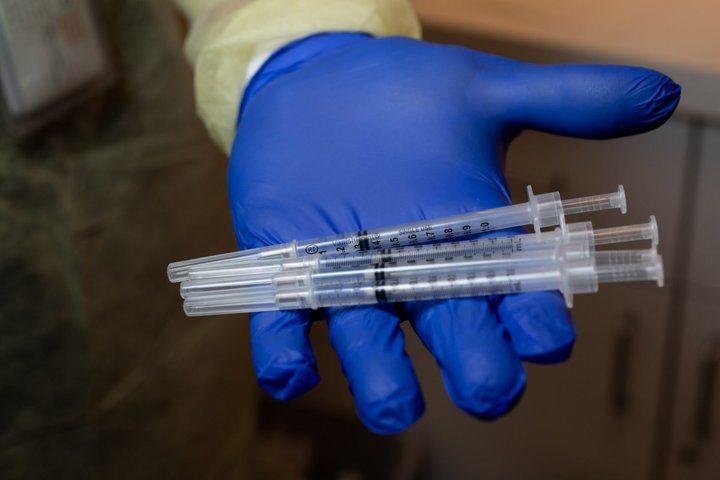
Patients at the St. John’s Well Child And Family Center in South Los Angeles were inoculated with the Pfizer COVID-19 vaccine. Photo by Shae Hammond for CalMatters
###
Another sudden shift in state policy has triggered an array of concerns and confusion today about how California’s still-scarce COVID-19 vaccine supplies will be divvied up.
Dr. Mark Ghaly, the state’s top health official, announced that 40% of California’s vaccine supply, starting with 2 million doses, will go to the poorest and most diverse communitIes.
“I’m lost, honestly, it’s just confusing,” one local health officer said at a board meeting today of the California Conference of Local Health Officers.
The county and city health officers — who run the vaccine programs in their communities — said they weren’t pleased that they only heard about the major policy shift from news outlets. Community clinics in those neighborhoods also said they were not notified.
Local health officials also highlighted a more immediate concern: As Sutter Health, one of the major vaccine providers in California, cancelled tens of thousands of vaccine appointments for lack of supply, county-run vaccine clinics are starting to see “Sutter refugees” — people who are scrambling to get their second doses before a certain deadline.
The communities receiving the 40% encompass 400 of the state’s ZIP codes, largely in Los Angeles County, the Inland Empire and the Central Valley, based on their low scores on the “Healthy Places Index,” which measures criteria such as income, education, park access, air pollution and housing.
Ghaly said about 1.6 million doses already have been administered to the underserved communities that the state is now targeting. So now those communities will receive at least 400,000 doses more in the next two weeks, double the current supply.
People in those ZIP codes must still meet eligibility requirements before they can be vaccinated — at this point, people 65 and older, health care workers, educators and some other essential workers.
The communities receiving the 40% encompass 400 of the state’s ZIP codes, largely in Los Angeles County, the Inland Empire and the Central Valley
Many questions remain about how the state will ensure doses get into the arms of people in those communities. Many counties and cities, particularly Los Angeles, Oakland and Long Beach, have affluent neighborhoods right next to poor neighborhoods. And some ZIP codes, such as one in Hawthorne and Manhattan Beach, contain both types of neighborhoods.
More appointments through the vaccine registration site, MyTurn.ca.gov, will be reserved for people living in the priority ZIP codes — an attempt to keep people from wealthier communities away.
And community clinics, which serve underserved communities, will be prioritized in the new vaccine network led by Blue Shield, Ghaly said. The state will also have mobile vaccination clinics and add resources for people who are homebound, he said.
“Sending (vaccine) there is one thing, but ensuring it gets to the arms of those living in these communities is another,” Ghaly said.
The allotment of 40% to certain communities raises questions about whether other populations of Californians will be pushed lower on the priority list. In addition, another 10% of doses have been earmarked in California for teachers and child care workers.
If those groups are prioritized for 50% of the doses, it follows that other groups — particularly people outside those ZIP codes who have high-risk health conditions — will be less of a priority.
But Ghaly said he expects vaccine shipments to increase over the next couple weeks, so he thinks other groups will not lose out. He predicts that all communities soon will get at least as many doses as — or more than — they currently receive.
“Of course targeting scarce resources to certain ZIP codes, certain communities, certain eligible populations is going to mean that some communities don’t get as much of an increase as others. But we expect that all communities will get at least as much as they’re getting now,” Ghaly said.
“Sending (vaccine) there is one thing, but ensuring it gets to the arms of those living in these communities is another.”
— Mark Ghaly, Secretary of California Health and Human Services
Ghaly said a disproportionate number of people with chronic conditions or disabilities live in the prioritized ZIP codes.
Californians with cancer, heart disease, diabetes and other high-risk disorders become eligible for vaccines on March 15. Guidance on how they can verify medical conditions and access vaccinations will be released in the coming days, Ghaly said.
Advocates have criticized California’s vaccination program for failing to serve poor communities of color, which have been battered by a high rate of COVID-19 infections.
Only about 16% of total vaccines administered in the state have gone to people in the bottom quarter of the Healthy Place Index. In comparison, 34% of the state’s vaccines have been administered in communities in the highest quarter.
California has adjusted its priority system several times since vaccines became available in December. It first put out a system based on employment and medical conditions, with health care workers and nursing homes prioritized. Then the state announced seniors 65 and over would be eligible to sign up, although some counties initially only opened it up to those 75 and over, noting lack of vaccine supply. Teachers and child care workers, along with some essential workers, such as food and agriculture, are now also eligible. State officials have said that after essential workers and people with underlying medical conditions, vaccination eligibility will be based on age.
The result is a dizzying array of constantly shifting priorities that confused and worried local health officials and advocates.
###
CalMatters COVID-19 coverage, translation and distribution is supported by generous grants from the Blue Shield of California Foundation, the California Wellness Foundation and the California Health Care Foundation.
CALmatters.org is a nonprofit, nonpartisan media venture explaining California policies and politics.
CLICK TO MANAGE